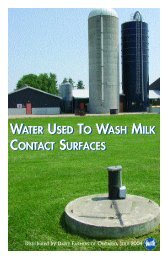Canadian Quality Milk On-Farm Food Safety Program - Centre ...
Canadian Quality Milk On-Farm Food Safety Program - Centre ...
Canadian Quality Milk On-Farm Food Safety Program - Centre ...
You also want an ePaper? Increase the reach of your titles
YUMPU automatically turns print PDFs into web optimized ePapers that Google loves.
<strong>Canadian</strong> <strong>Quality</strong> <strong>Milk</strong><br />
drug was itself given according to the label.<br />
• Using an unapproved vNHP without a veterinary prescription.<br />
Under federal regulations, producers are legally obliged to follow the exact instructions<br />
included on the product label and insert. Producers can use drugs in an extra-label<br />
manner only under the direct supervision of a veterinarian. This condition applies to<br />
both over-the-counter and prescription drugs, even if the drug to be used was not<br />
purchased from a veterinarian, e.g. a livestock medicines outlet.<br />
Licensed veterinarians are permitted to dispense livestock medicines and recommend<br />
extra-label usage, but they can do so only under certain conditions. When prescribing<br />
extra-label use of a drug, the veterinarian assumes responsibility for any damages and<br />
adverse reactions that might occur as a result of the extra-label use. In many<br />
provinces, and with this program, the veterinarian is required to provide written<br />
instructions on the use of the livestock medicine, including appropriate<br />
withdrawal times.<br />
Please note: In Quebec, all medications administered to dairy animals must be accompanied<br />
by a written veterinary prescription.<br />
4.4 ADMINISTRATION OF TREATMENTS<br />
4.4.1 Administering Injections<br />
Record the identity of any animals carrying broken needles and record the site<br />
of injection. Have a veterinarian find and remove the needles, or, if this is not<br />
possible, inform the packing plant or next buyer of contaminated animals. This will<br />
reduce the risk of contaminated meat becoming human food.<br />
When given the choice on the label, give livestock medicines under the skin<br />
(subcutaneously) rather than in the muscle. If intramuscular injection is necessary,<br />
using proper injection techniques will reduce the possibility of damaging the muscle,<br />
and increase the chances treatment will be successful.<br />
Use the side of the neck (preferred site) for injections into muscle. Using this site<br />
greatly reduces the chances of damaging the more valuable rump cuts of meat. The<br />
same site can be used for giving injections to both calves and adult cattle.<br />
Properly identify the injection site, by identifying the neck bones that run roughly<br />
along a line between the base of the ear and the point of the shoulder. If you stay<br />
above this line and the width of your hand below the crest of the neck, you can<br />
safely inject into the large neck muscles. Start two to three inches ahead of the<br />
shoulder blade. If you move one hand's-width closer to the head, you can give<br />
another injection on the same side. You can use both sides of the neck.<br />
Use clean, sharp needles when giving injections into muscle to prevent bruising<br />
and tearing of muscle fibres at the injection site and to reduce the risk of needle<br />
breakage in muscle tissue.<br />
• Ideally use a new single use needle for each injection.<br />
June 2010 4—17
















